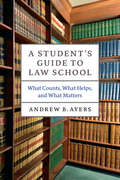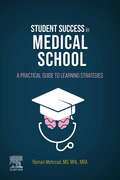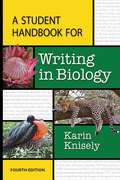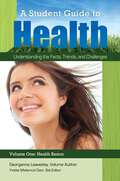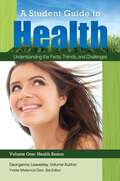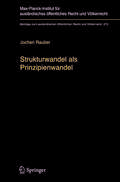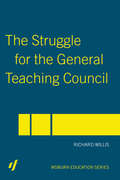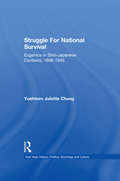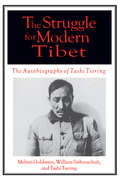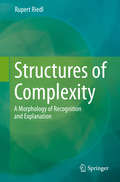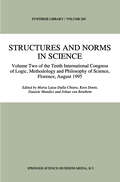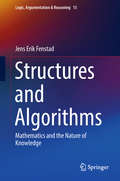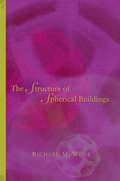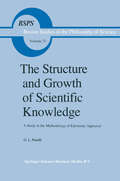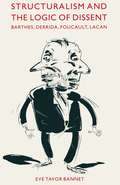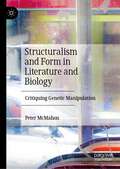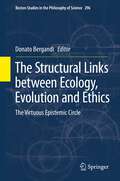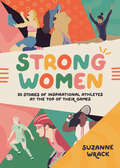- Table View
- List View
A Student's Guide to Law School: What Counts, What Helps, and What Matters (Chicago Guides to Academic Life)
by Andrew B. AyersLaw school can be a joyous, soul-transforming challenge that leads to a rewarding career. It can also be an exhausting, self-limiting trap. It all depends on making smart decisions. When every advantage counts, A Student’s Guide to Law School is like having a personal mentor available at every turn. As a recent graduate and an appellate lawyer, Andrew Ayers knows how high the stakes are—he’s been there, and not only did he survive the experience, he graduated first in his class. In A Student’s Guide to Law School he shares invaluable insight on what it takes to make a successful law school journey. Originating in notes Ayers jotted down while commuting to his first clerkship with then-Judge Sonia Sotomayor, and refined throughout his first years as a lawyer, A Student’s Guide to Law School offers a unique balance of insider’s knowledge and professional advice. Organized in four parts, the first part looks at tests and grades, explaining what’s expected and exploring the seven choices students must make on exam day. The second part discusses the skills needed to be a successful law student, giving the reader easy-to-use tools to analyze legal materials and construct clear arguments. The third part contains advice on how to use studying, class work, and note-taking to find your best path. Finally, Ayers closes with a look beyond the classroom, showing students how the choices they make in law school will affect their career—and even determine the kind of lawyer they become. The first law school guide written by a recent top-ranked graduate, A Student’s Guide to Law School is relentlessly practical and thoroughly relevant to the law school experience of today’s students. With the tools and advice Ayers shares here, students can make the most of their investment in law school, and turn their valuable learning experiences into a meaningful career.
A Student's Guide to Law School: What Counts, What Helps, and What Matters (Chicago Guides to Academic Life)
by Andrew B. AyersLaw school can be a joyous, soul-transforming challenge that leads to a rewarding career. It can also be an exhausting, self-limiting trap. It all depends on making smart decisions. When every advantage counts, A Student’s Guide to Law School is like having a personal mentor available at every turn. As a recent graduate and an appellate lawyer, Andrew Ayers knows how high the stakes are—he’s been there, and not only did he survive the experience, he graduated first in his class. In A Student’s Guide to Law School he shares invaluable insight on what it takes to make a successful law school journey. Originating in notes Ayers jotted down while commuting to his first clerkship with then-Judge Sonia Sotomayor, and refined throughout his first years as a lawyer, A Student’s Guide to Law School offers a unique balance of insider’s knowledge and professional advice. Organized in four parts, the first part looks at tests and grades, explaining what’s expected and exploring the seven choices students must make on exam day. The second part discusses the skills needed to be a successful law student, giving the reader easy-to-use tools to analyze legal materials and construct clear arguments. The third part contains advice on how to use studying, class work, and note-taking to find your best path. Finally, Ayers closes with a look beyond the classroom, showing students how the choices they make in law school will affect their career—and even determine the kind of lawyer they become. The first law school guide written by a recent top-ranked graduate, A Student’s Guide to Law School is relentlessly practical and thoroughly relevant to the law school experience of today’s students. With the tools and advice Ayers shares here, students can make the most of their investment in law school, and turn their valuable learning experiences into a meaningful career.
A Student's Dictionary of Psychology and Neuroscience
by Dr Nicky Hayes Peter StrattonThis is the essential reference work for any student studying psychology for the first time. Packed with easy-to-understand definitions and helpful diagrams, the new edition has been expanded to include the key concepts within the growing field of neuroscience, as well as greater coverage of positive psychology. Key features include: over 2,500 entries extensive cross-referencing for easy navigation mini biographies of key psychologists list of key reference works study notes section list of common abbreviations Also including a list of key references in the field and a guide to writing essays and referencing your work, this is the perfect accompaniment for any student newly encountering this fascinating subject, those taking related disciplines in the health or social sciences, or professionals wanting to familiarise themselves with key terms and ideas.
A Student's Dictionary of Psychology and Neuroscience
by Nicky Hayes Peter StrattonAn essential reference work for any student studying psychology for the first time, A Student's Dictionary of Psychology and Neuroscience (Seventh Edition) provides over 2,500 definitions of complex concepts in clear and accessible language alongside helpful diagrams. The dictionary offers comprehensive coverage of the main contemporary terms in psychology and neuroscience. This new edition features updated references which will be particularly relevant to the key areas of neuroscience and neuropsychology and also to recent concepts of psychological significance, such as expanded coverage of research methods, internet psychology, cognitive psychology and social psychology. The dictionary also features end material with useful notes for constructing student essays as well as key references and a list of common abbreviations. Extensive cross-referencing allows students to follow up and identify further details of a given topic, and mini-biographies of key psychologists help to provide relevant context. A Student's Dictionary of Psychology and Neuroscience is the perfect accompaniment for any student newly encountering this fascinating subject, those taking related disciplines in the health or social sciences, or professionals wanting to familiarise themselves with key terms and ideas.
A Student's Dictionary of Psychology and Neuroscience
by Nicky Hayes Peter StrattonAn essential reference work for any student studying psychology for the first time, A Student's Dictionary of Psychology and Neuroscience (Seventh Edition) provides over 2,500 definitions of complex concepts in clear and accessible language alongside helpful diagrams. The dictionary offers comprehensive coverage of the main contemporary terms in psychology and neuroscience. This new edition features updated references which will be particularly relevant to the key areas of neuroscience and neuropsychology and also to recent concepts of psychological significance, such as expanded coverage of research methods, internet psychology, cognitive psychology and social psychology. The dictionary also features end material with useful notes for constructing student essays as well as key references and a list of common abbreviations. Extensive cross-referencing allows students to follow up and identify further details of a given topic, and mini-biographies of key psychologists help to provide relevant context. A Student's Dictionary of Psychology and Neuroscience is the perfect accompaniment for any student newly encountering this fascinating subject, those taking related disciplines in the health or social sciences, or professionals wanting to familiarise themselves with key terms and ideas.
Student Success in Medical School E-Book: A Practical Guide to Learning Strategies
by Raman MehrzadUsing proven methods of studying, learning, and reading, Student Success in Medical School delivers the practical, real-world information you need to optimize your learning and analytic abilities in medical school and beyond. Written by a medical doctor who understands exactly what it takes to increase educational performance, this comprehensive guide covers all the important elements involved in learning new knowledge, how to balance your studies and clinical rotations, and most importantly, how to apply knowledge in clinical practice. Explore the proven methods of studying, learning, and reading that work best for different types of students—all based on the latest research in learning strategies and why they’re beneficial. Learn the best strategies for taking different types of exams, time management, and how to balance your studies with a healthy lifestyle. Discover how to read faster, learn more efficiently, and apply the knowledge to your field. Benefit from concise, easy-to-read chapters on stress management, healthcare literacy, motivation and mindset, goals and goal setting, accelerated learning, mentors, memorization techniques, and much more.
A Student Handbook For Writing In Biology
by Karin KniselyProviding practical advice to students on how to write for biology, this book shows how to write for a particular audience, self evaluate drafts, and paraphrase for improved comprehension.
A Student Guide to Health [5 volumes]: Understanding the Facts, Trends, and Challenges [5 volumes]
by Georganna Leavesley Alice C. Richer Nancy A. Piotrowski Yvette Malamud OzerThis comprehensive, five-volume reference set is aligned with the National Health Education Standards, containing up-to-date, scientifically based information on a variety of health and wellness topics relevant to high school students.A Student Guide to Health: Understanding the Facts, Trends, and Challenges provides straightforward, factual, and accessible information about a multitude of health issues. It is an essential reference set that provides high school students, teachers, and administrators with a comprehensive health and wellness education resource that aligns with National Health Education Standards and common health curriculum. This expansive five-volume set is ideal for students' research projects; highly useful as a resource for community college and public library patrons, librarians, teens, and parents; and is a suitable supplement to any health education curriculum.Each chapter includes up-to-date, evidence-based information that provokes further examination and encourages critical thinking to evaluate the validity of information encountered about health and wellness topics. Each chapter provides an abundance of references and lists of resources for further information, including books, articles, websites, organizations, and hotlines. Special attention is paid to social trends that affect youth health and wellness, such as bullying, eating disorders, steroid abuse, sexting, and the peer pressure associated with drug use and abuse.
A Student Guide to Health [5 volumes]: Understanding the Facts, Trends, and Challenges [5 volumes]
This comprehensive, five-volume reference set is aligned with the National Health Education Standards, containing up-to-date, scientifically based information on a variety of health and wellness topics relevant to high school students.A Student Guide to Health: Understanding the Facts, Trends, and Challenges provides straightforward, factual, and accessible information about a multitude of health issues. It is an essential reference set that provides high school students, teachers, and administrators with a comprehensive health and wellness education resource that aligns with National Health Education Standards and common health curriculum. This expansive five-volume set is ideal for students' research projects; highly useful as a resource for community college and public library patrons, librarians, teens, and parents; and is a suitable supplement to any health education curriculum.Each chapter includes up-to-date, evidence-based information that provokes further examination and encourages critical thinking to evaluate the validity of information encountered about health and wellness topics. Each chapter provides an abundance of references and lists of resources for further information, including books, articles, websites, organizations, and hotlines. Special attention is paid to social trends that affect youth health and wellness, such as bullying, eating disorders, steroid abuse, sexting, and the peer pressure associated with drug use and abuse.
Strukturwandel als Prinzipienwandel: Theoretische, dogmatische und methodische Bausteine eines Prinzipienmodells des Völkerrechts und seiner Dynamik (Beiträge zum ausländischen öffentlichen Recht und Völkerrecht #272)
by Jochen RauberDas Buch versucht, zu einem besseren Verständnis des Strukturwandels des Völkerrechts beizutragen. Zu diesem Zweck entwirft es ein Prinzipienmodell des Völkerrechts, mit dem sich die völkerrechtlichen Entwicklungen, an die die Strukturwandelthese anknüpft, theoretisch erklären und dogmatisch erfassen lassen. Es weist nach, dass die Regeln des Völkerrechts in normativer Hinsicht auf völkerrechtlichen Grundprinzipien aufbauen, zeigt, dass der Bestand dieser Prinzipien wächst und analysiert, inwieweit das Aufkommen neuer Völkerrechtsprinzipien das Verständnis bestehender Völkerrechtsregeln beeinflusst. Ausgehend hiervon plädiert das Werk dafür, die Erscheinungen des völkerrechtlichen Strukturwandels als Konsequenz von Veränderungen im Bestand völkerrechtlicher Grundprinzipien zu verstehen. An Fallstudien aus unterschiedlichen Teilbereichen des Völkerrechts wird die Theorie abschließend erprobt.
The Struggle for the General Teaching Council
by Richard WillisThis book chronicles the history of the struggle to promote a self-governing body for the teaching profession from its early problems at the start of the twentieth century right through to the establishment of the General Teaching Council of England in 2000. It also explores the interest groups and policy makers who impeded its achievement and the attitude of teacher unions and the teachers themselves to the establishment of such a body.The book will be of interest to academics, researchers and historians, as well as postgraduate students.
The Struggle for the General Teaching Council (Woburn Education Ser.)
by Richard WillisThis book chronicles the history of the struggle to promote a self-governing body for the teaching profession from its early problems at the start of the twentieth century right through to the establishment of the General Teaching Council of England in 2000. It also explores the interest groups and policy makers who impeded its achievement and the attitude of teacher unions and the teachers themselves to the establishment of such a body.The book will be of interest to academics, researchers and historians, as well as postgraduate students.
Struggle For National Survival: Chinese Eugenics in a Transnational Context, 1896-1945 (East Asia: History, Politics, Sociology and Culture)
by Yuehtsen Juliette ChungThis dissertation is a historical investigation of the relationship between science and society through the comparative study of eugenics movements as they developed in both Japan and China from the 1890's to the 1940's.
Struggle For National Survival: Chinese Eugenics in a Transnational Context, 1896-1945 (East Asia: History, Politics, Sociology and Culture)
by Yuehtsen Juliette ChungThis dissertation is a historical investigation of the relationship between science and society through the comparative study of eugenics movements as they developed in both Japan and China from the 1890's to the 1940's.
The Struggle for Modern Tibet: The Autobiography of Tashi Tsering
by Melvyn C. Goldstein William R Siebenschuh Tashi TseringThis captivating autobiography by a Tibetan educator and former political prisoner is full of twists and turns. Born in 1929 in a Tibetan village, Tsering developed a strong dislike of his country's theocratic ruling elite. As a 13-year-old member of the Dalai Lama's personal dance troupe, he was frequently whipped or beaten by teachers for minor infractions. A heterosexual, he escaped by becoming a drombo, or homosexual passive partner and sex-toy, for a well-connected monk. After studying at the University of Washington, he returned to Chinese-occupied Tibet in 1964, convinced that Tibet could become a modernized society based on socialist, egalitarian principles only through cooperation with the Chinese. Denounced as a 'counterrevolutionary' during Mao's Cultural Revolution, he was arrested in 1967 and spent six years in prison or doing forced labor in China. Officially exonerated in 1978, Tsering became a professor of English at Tibet University in Lhasa. He now raises funds to build schools in Tibet's villages, emphasizing Tibetan language and culture.
The Struggle for Modern Tibet: The Autobiography of Tashi Tsering (Mellen Studies In Education Ser. #Vol. 88)
by Melvyn C. Goldstein William R Siebenschuh Tashi TseringThis captivating autobiography by a Tibetan educator and former political prisoner is full of twists and turns. Born in 1929 in a Tibetan village, Tsering developed a strong dislike of his country's theocratic ruling elite. As a 13-year-old member of the Dalai Lama's personal dance troupe, he was frequently whipped or beaten by teachers for minor infractions. A heterosexual, he escaped by becoming a drombo, or homosexual passive partner and sex-toy, for a well-connected monk. After studying at the University of Washington, he returned to Chinese-occupied Tibet in 1964, convinced that Tibet could become a modernized society based on socialist, egalitarian principles only through cooperation with the Chinese. Denounced as a 'counterrevolutionary' during Mao's Cultural Revolution, he was arrested in 1967 and spent six years in prison or doing forced labor in China. Officially exonerated in 1978, Tsering became a professor of English at Tibet University in Lhasa. He now raises funds to build schools in Tibet's villages, emphasizing Tibetan language and culture.
Structures of Complexity: A Morphology of Recognition and Explanation
by Rupert RiedlIn this book, the author Rupert Riedl investigates the structural and functional correlations of issues considered as "complex". He brilliantly analyzes the definition of complexity, the occurrence of complexity, the meaning of complexity, and last-but-not-least the way complexity is dealt with professionally.In recent years, our view of the world has been split into ever smaller segments – in part due to the increasing importance of the natural sciences and their associated analytical power. This calls for once again focusing on complexity and the holistic aspects, on interdisciplinary and synoptic approaches. This book is a translation of the original German version “Strukturen der Komplexität”, which was published in 2000. The discussion of complexity from the perspective of a biologist has long been overdue when it was published and is still up-to-date.
Structures and Norms in Science: Volume Two of the Tenth International Congress of Logic, Methodology and Philosophy of Science, Florence, August 1995 (Synthese Library #260)
by JohanBenthem DanieleMundici KeesDoets Maria Luisa DallaChiaraThis book gives a state-of-the-art survey of current research in logic and philosophy of science, as viewed by invited speakers selected by the most prestigious international organization in the field. In particular, it gives a coherent picture of foundational research into the various sciences, both natural and social. In addition, it has special interest items such as symposia on interfaces between logic and methodology, semantics and semiotics, as well as updates on the current state of the field in Eastern Europe and the Far East.
Structures and Algorithms: Mathematics and the Nature of Knowledge (Logic, Argumentation & Reasoning #15)
by Jens Erik FenstadThis book explains exactly what human knowledge is. The key concepts in this book are structures and algorithms, i.e., what the readers “see” and how they make use of what they see. Thus in comparison with some other books on the philosophy (or methodology) of science, which employ a syntactic approach, the author’s approach is model theoretic or structural. Properly understood, it extends the current art and science of mathematical modeling to all fields of knowledge. The link between structure and algorithms is mathematics. But viewing “mathematics” as such a link is not exactly what readers most likely learned in school; thus, the task of this book is to explain what “mathematics” should actually mean. Chapter 1, an introductory essay, presents a general analysis of structures, algorithms and how they are to be linked. Several examples from the natural and social sciences, and from the history of knowledge, are provided in Chapters 2–6. In turn, Chapters 7 and 8 extend the analysis to include language and the mind. Structures are what the readers see. And, as abstract cultural objects, they can almost always be seen in many different ways. But certain structures, such as natural numbers and the basic theory of grammar, seem to have an absolute character. Any theory of knowledge grounded in human culture must explain how this is possible. The author’s analysis of this cultural invariance, combining insights from evolutionary theory and neuroscience, is presented in the book’s closing chapter. The book will be of interest to researchers, students and those outside academia who seek a deeper understanding of knowledge in our present-day society.
The Structure of Spherical Buildings
by Richard M. WeissThis book provides a clear and authoritative introduction to the theory of buildings, a topic of central importance to mathematicians interested in the geometric aspects of group theory. Its detailed presentation makes it suitable for graduate students as well as specialists. Richard Weiss begins with an introduction to Coxeter groups and goes on to present basic properties of arbitrary buildings before specializing to the spherical case. Buildings are described throughout in the language of graph theory. The Structure of Spherical Buildings includes a reworking of the proof of Jacques Tits's Theorem 4.1.2. upon which Tits's classification of thick irreducible spherical buildings of rank at least three is based. In fact, this is the first book to include a proof of this famous result since its original publication. Theorem 4.1.2 is followed by a systematic study of the structure of spherical buildings and their automorphism groups based on the Moufang property. Moufang buildings of rank two were recently classified by Tits and Weiss. The last chapter provides an overview of the classification of spherical buildings, one that reflects these and other important developments.
The Structure and Growth of Scientific Knowledge: A Study in the Methodology of Epistemic Appraisal (Boston Studies in the Philosophy and History of Science #73)
by G.L. PanditProfessor Pandit, working among the admirable group of philosophers at the University of Delhi, has written a fundamental criticism and a constructive re-interpretation of all that has been preserved as serious epistemological and methodological reflections on the sciences in modern Western philosoph- from the times of Galileo, Newton, Descartes and Leibniz to those of Russell and Wittgenstein, Carnap and Popper, and, we need hardly add, onward to the troubling relativisms and reconstructions of historical epistemologies in the works of Hanson, Kuhn, Lakatos and Feyerabend. His themes are intrigu ing, set forth as they are with masterly case studies of physics and the life sciences, and within an original conceptual framework for philosophical analysis of the processes, functions, and structures of scientific knowing. Pandit's contributions deserve thoughtful examination. For our part, we wish to point to some among them: (1) an interactive articulation of subjective and objective factors of both problems and theories in the course of scientific development; (2) a striking contrast between the explanatory power of a scientific theory and its 'resolving power', i. e.
Structuralism and the Logic of Dissent: Barthes, Derrida, Foucault, Lacan
by Eve Tavor BannetStructuralism and the Logic of Dissent is a fascinating and lucid exploration of the seminal writings of four eminent French structuralists that sheds new light on influential theoretical texts. Eve Tavor Bannet discusses the work of Barthes, Derrida, Foucault, and Lacan as coherent philosophical fictions, showing their contradictory political, social, and pedagogical implications and their complex historicity.
Structuralism and Form in Literature and Biology: Critiquing Genetic Manipulation
by Peter McMahonThe book considers biology in parallel with philosophical structuralism in order to argue that notions of form in the organism are analogous to similar ideas in structuralist philosophy and literary theory. This analogy is then used to shed light on debates among biological scientists from the turn of the 19th century to the present day, including Cuvier, Geoffroy Saint-Hilaire, Dawkins, Crick, Goodwin, Rosen and West-Eberhard. The book critiques the endorsement of genetic manipulation and bioengineering as keys to solving agricultural and environmental problems, suggesting that alternative models have been marginalized in the promotion of this discourse. Drawing from the work of philosophers including Cassirer, Saussure, Jakobson and Foucault the book ultimately argues that methods based on agroecology, supported by molecular applications (such as marker-assisted selection, MAS), can both advance agricultural development and remain focused on the whole organism.
The Structural Links between Ecology, Evolution and Ethics: The Virtuous Epistemic Circle (Boston Studies in the Philosophy and History of Science)
by Donato BergandiEvolutionary biology, ecology and ethics: at first glance, three different objects of research, three different worldviews and three different scientific communities. In reality, there are both structural and historical links between these disciplines. First, some topics are obviously common across the board. Second, the emerging need for environmental policy management has gradually but radically changed the relationship between these disciplines. Over the last decades in particular, there has emerged a need for an interconnecting meta-paradigm that integrates more strictly evolutionary studies, biodiversity studies and the ethical frameworks that are most appropriate for allowing a lasting co-evolution between natural and social systems. Today such a need is more than a mere luxury, it is an epistemological and practical necessity.
Strong Women: Inspirational athletes at the top of their game
by Suzanne WrackOverpower. Overtake. Overcome. – Serena WilliamsThroughout history, every woman pulling on spikes, lacing up boots and picking up a racquet has been a rebel – and this explosive book aims to uncover the often hidden histories behind 50 of these incredible pioneers.From the first Black woman to be a professional softball player, Betty Chapman, to the iconic 'Battle of the Sexes' match won by Billie Jean King, and from trans trailblazer Laurel Hubbard to Emma Raducanu's unforgettable US Open win, award-winning sports journalist Suzanne Wrack celebrates sporting giants at the absolute top of their games.
